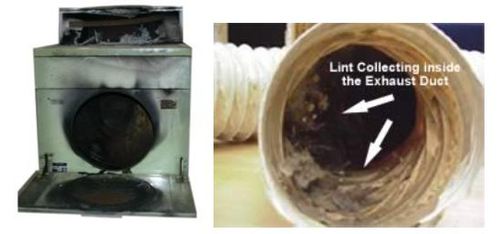What household appliance causes more than 1,000 residential fires per month in the US? The answer… your clothes dryer!
They are a modern marvel and an indispensable convenience. We use them constantly and they work so well that we tend to ignore them until they make funny noises or quit working. But, taking your clothes dryer for granted is a BIG mistake. Your clothes dryer is one of the most common causes of household fires. If clothes dryers are not properly installed or maintained, life threatening fires can occur.
Annually, on average, there are more than 12,000 house fires causing $88 million in property damage, 300 injuries and 15 fatalities caused by clothes dryers according to a FEMA study. The worst part is they are nearly all preventable losses.
What causes clothes dryer fires?
“Failure to clean” is the leading factor contributing to clothes dryer fires. Clothes dryers must vent hot air from the dryer to the outside of the house. During the drying process, damp lint from clothes is carried through the exhaust system. As lint builds up in the exhaust pipe or inside the dryer it slows down the air movement out the exhaust and overheats the dryer. The slower air movement causes even more lint to collect on the backside of dryer drum, on the dryer motor, and on the electrical connections inside the dryer. This places highly combustible lint fibers adjacent to the heat sources inside the dryer which may ultimately lead to a fire.
Don’t ignore these signs that your dryer vent may be obstructed:
- Clothing is still damp at the end of a typical drying cycle
- Drying requires longer times than normal
- Clothes feel hotter than usual at the end of the cycle
- Outside the dryer is unusually hot
- Damper (or flappers) on exhaust termination doesn’t open or barely opens during drying
- Laundry room feels warmer or more humid than normal
- Burnt smell in laundry room
TAKE ACTION! What Can a Homeowner Do?
- At least once a year have your dryer serviced and cleaned to remove any lint collected on the motor, wires and inside the exhaust pipe. This is critical to safe operation of your dryer.
- Replace the white vinyl type flexible exhaust hose with flexible metal or sheet metal vent pipe. The metal is more fire resistant and can help contain a fire should one start. Metal pipe is also less likely to kink than vinyl exhaust hose.
- Exhaust hoses should be kept as short as possible and have a minimum of bends to facilitate adequate airflow.
- Locate the dryer as close to an outside wall as possible for safe venting.
- Do not operate your dryer when no one is home or while you are sleeping.
For more detailed information read “Clothes Dryer Fires in Residential Buildings”, a FEMA Publication, Topical Fire Research Series, Vol 7, Issue 1



Discussion
There are no comments yet.